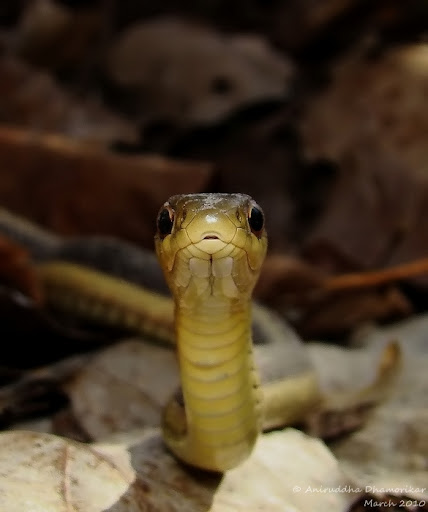Among the Garter Snakes
 |
| Eastern Garter Snake, Thamnophis sirtalis sirtalis |
I remember shuffling through pages of Childcraft as a kid, when I was more interested in pictures than the text. My father had bought a set of these books that further nurtured my interest in science and nature. After years, I forgot about these introductory books, although I obscurely remember the pictures and drawings in them. This amazing children’s encyclopedia was my gateway to beautiful photographs, drawings and the vast knowledge. It was in those days that I started observing around, looking for bugs, building bird nests and wishing dinosaurs were still alive. It was then, more than ten years ago when I first saw pictures of snakes – hundreds of them living together. It was when I saw a documentary on these many, many snakes living together called Garter Snakes, that I became interested in them.
| Looking through the thickets |
After a few fruitless walks at Medway Creek, I was furious about my camera’s failure to focus. It took several clicks to focus on one object; hence photographing birds was beyond my capabilities. Just as I walked carefully through the thickets, something stirred in the undergrowth. I was so happy to see a snake hurry through the grass! I carefully followed it, making sure I did not panic it out of excitement. It, henceforth referred to as he, froze for a moment, raised his head and looked at me intensely. This was the first time I photographed a snake in Canada.
| Garter Snakes raise their head and sit motionless if they sense danger |
Now Garter Snakes were high in my wish-list of Canadian wildlife. I had seen one back in September, but I did not have a camera with me then. This time was the best to observe them and I had been wondering if they are out of hibernation yet. As is the law of nature to always expect to see the least expected, I saw my first garter snake unexpectedly. I adjusted myself to take more pictures, just when another scurried away from where I sat. That did panic me, since I am not very good at handling or facing snakes. I wasn’t surprised to see two snakes together though, which is in fact pretty rare to see in India unless it’s a mating pair or two rival males. This fellow decided to dash into dense undergrowth with a flicking tongue, and left me wondering if I will ever get a decent picture of this snake again. I called off my birding walk temporarily, and decided to look for more snakes. Two garters was a good sign that there will be many more around.
| Spring is the best time to observe these snakes as they emerge in vast numbers |
Garter Snakes are known to hibernate in vast numbers during winter months. Their hibernacula, place where they rest are underground and well hidden from winter’s wrath. Come March and they will be seen fairly commonly all around. Garter Snakes are the commonest snakes seen in North America, and are one of the two snakes that can live farther up north.
| Once assured of no threat, they are friendly and let you come close without having to catch them! |
The Eastern Garter Snake which I saw were all males. March is the season of reproduction, when the males are the first to arise from hibernation. The males then wait around the hibernacula for the females, and courtship begins as soon as possible. A male will mate with several females, but it is not as easy as it seems. When the males come out, one of them mimics the pheromones produced by the females that attract males. Thus, the other males follow him and he takes them farther from where females are hibernating. After leading the trail, he switches to his male pheromones, and traces back the way to the hibernacula. Now he has better chances of reproduction than the others that he fooled! This interesting behavior is observed during months of March-April.
| Eastern Garter Snakes are medium sized, measuring 48 - 70 cm |
Eastern Garter Snakes show many color morphs, a character seen in all Garter Snakes. However, Garter Snakes are easy to identify by the typical three longitudinal stripes along the back. Identifying them up to species level can sometimes be difficult. This is because of the difference in scaling patterns in a single species.
| A few movements made this fellow flick his tongue! |
As I sat and photographed this male, I saw many more surrounding me. None of the ones that were very near felt threatened and some even crawled over my leg. Garter Snakes are not aggressive, but they are wary and can be easily disturbed. They will either freeze or dash for cover. To be amongst tens of them, and them accepting me as a part of the habitat was a cherry on the cake.
Garter Snakes, because of their friendly nature, are considered good pets. Many are caught directly from the wild and kept in terrariums. These snakes feed on spiders, frogs, lizards and little rodents, thus with such easily available food and low maintenance, they are ideal in the market and sold for around $20.
| An Eastern Garter Snake sensing the surrounding |
After spending several hours photographing these snakes, I returned to the same location on the next day to video document them. I will be writing a new post on that one sometime later during the month. It is called “Toby: An Eastern Garter Snake”. I followed Toby for two hours, observing his moves.
(22 May 2011) Update! The documentary is complete. Watch and read about Toby Garter: A Short Video Documentary!
(22 May 2011) Update! The documentary is complete. Watch and read about Toby Garter: A Short Video Documentary!
Comments
Post a Comment